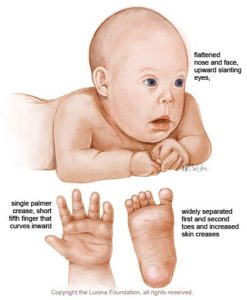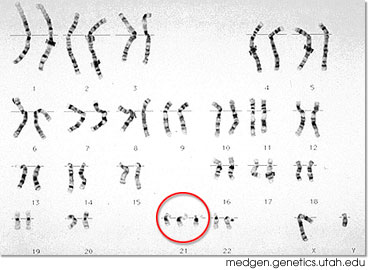Down syndrome is a genetic and chromosomal disorder where a person has either half of or a full extra 21st chromosome. The disorder was  first discovered by John Langdon Down, a British doctor, who first described the disease in 1866.
first discovered by John Langdon Down, a British doctor, who first described the disease in 1866.
Down syndrome is caused by a chromosomal abnormality which causes a replication of the 21st chromosome. The severity of the disease depends on the length of the replication of the chromosome. For example, if a person only has a slight replication of the 21st chromosome, then the extent of their disability is not nearly as severe.
Down syndrome has several mental and physical effects on those with the condition. People with Down syndrome are often shorter than most people. A person with Down syndrome also would have very distinct facial features. They would have an oblique eye shape, poor muscle tone, a flat nasal bridge, and a protruding tongue. A person with Down syndrome does not have as long of a life span as the average person.
Down syndrome is commonly related to congenital heart failure. This causes a person with Down syndrome to have a life span of 49 years. People who have Down syndrome are also mentally challenged. They do not have the capacity to handle as much information as the average person.
Down syndrome is detected through two ways. The first way is through birth. Down syndrome is partly classified as a physical disability making it obvious upon birth that a child has been born with the problem. However, a baby will still be taken in for tests afterwards to help determine if he or she does in fact have Down syndrome. A new technology and more popular way of discovering whether a child has Down syndrome is called Prenatal screening.
This is a test done for pregnant women to determine whether they carry genetic diseases that the may have passed to their child. The two types of prenatal screenings are called Amniocentesis and Chorionic villus sampling (CVS). Amniocentesis is a process by which amniotic fluid is extracted from the area around a developing fetus. It is then examined to determine if there are any genetic abnormalities in the child. The main reason for the popularity of the procedure is because it can be done 13 weeks into a pregnancy, so a family can decide on how to raise the child.
Chorionic villus Sampling is when a piece of placental tissue is taken which also determines genetic abnormalities. This procedure is more commonly used to determine Down syndrome, but it is only used for woman over 35, who have a higher risk of developing a child with the disease.
Down syndrome is not very common, but there are several people with the disorder. Today, there is a 1/800 chance of a person having a baby  with Down syndrome. It is more common for a woman to conceive a child with Down syndrome as they get older. Between the ages 20-24 there is only a 1/1490 chance that there will be a baby born with Down syndrome.
with Down syndrome. It is more common for a woman to conceive a child with Down syndrome as they get older. Between the ages 20-24 there is only a 1/1490 chance that there will be a baby born with Down syndrome.
By the time a woman is 30, the chance of Down syndrome is 1/500. Then, by the time a parent is 40 Down syndrome becomes very possible, as there is a 1/60 chance of a child being born with Down syndrome. As a person gets to be as old as 50 it is no longer safe to have a child without Down syndrome. The odds are that 1/11 children will be born with the disorder.
There is no real way of treating the disease after a child has been born. There are treatments to help with effects that come with Down syndrome. For example, as stated earlier, congenital heart failure is quite common in people with Down syndrome. Therefore, different medications that help deal with that problem are given to the people with Down syndrome. People with Down syndrome can obviously not be treated for their mental disabilities, but they are placed in special classes to help ease their education to their intelligence level.
